China Silk Road, a magical trade route not only for the merchandise but also for cultures. Xinjiang, an important city on the ancient China Silk Road, boasts splendid natural scenery and rich cultural sites. Do you want to know where will the merchants do business on the Silk Road? Do you want to experience the culture mix between western counties and ancient China on the Silk Road? Come and join this 7 days Xinjiang Deep Touch Tour with Silk Road and it will meet all your needs. This tour will take you to Urumqi, Turpan, and Kashgar. You will have a chance to visit the bazaar, caves, mosque and so on which are with strong ethnic culture. You will also visit the city ruins which have a history of more than 2,000 years. Make a reservation now and get on the flight tomorrow. This China Silk Road tour in Xinjing will surely make you impressed.

Welcome to the Deep Touch Tour in Xinjiang to explore the mystery along the ancient Silk Road. When you arrive at Urumqi Diwopu International Airport, our professional guide will be waiting for you at the arrival hall, holding a sign with your name on it. Then you will be transferred to the hotel to have a good rest. There will be no scheduled visit today, so you can just walk around by yourself if you like. If you would like to relax after a long flight, you can just have a rest in your room.
Free time suggestion: a visit to Red Hill Park. As one of the landmarks of Urumqi, the park is the best known in the city. Inside the park, there stands a hill formed by red gravel, from which the park got its name. The hill boasts rich fossil resources, and it is said that a fossil exactly like a human footprint dating back to 270 million years ago was ever discovered on the hill. Getting to the top of the hill, you can see the famous Mount Bogda in the distance and even have a bird’s-eye view of the whole city.
Besides the beautiful landscape, there are many stories about the Red Hill, and one of them has it that: In ancient times, a giant red dragon escaped out of the Heavenly Lake and made waves in the Urumqi River, making people suffer a lot. Having known about this, the Queen Mother on the Heaven killed the dragon and cut it into two halves, one of which turned into the Red Hill. Later, people built a pagoda on the hill to repress the evil spirit of the dragon, and the pagoda has been standing in the park since the Qing Dynasty (1636-1912).
 Turpan
Turpan After breakfast, you will drive southeast to Turpan. Located in the central part of Xinjiang Uygur Autonomous Region, Turpan is about 200 kilometers away from Urumqi, which is about three hours’ drive. Upon your arrival, you will have lunch first and then tour around the city.
Turpan used to be an important town along the ancient Silk Road, and traces of human existence founded here can date back to the Neolithic Age. Moreover, enjoying exceptional geographic advantages, Turpan is not only rich in mineral resources but also abound in fruits, especially watermelons and grapes. But in fact, the temperature in summer here can reach 49.5 degrees centigrade and the mean annual precipitation here is only 16.4mm. If you’re wondering how such a hot place with little rainfall can be a hub for fruit growing, you may find the answer in the next stop: Karez Well.
Dating back more than 2000 years, Karez Well, also known as Kariz or Kahriz, refers to an irrigation system of wells connected by underground channels. Data shows that there are 1,327 Kanze wells in Turpan Basin, amounting to more than 5,000 kilometers long. Turpan has been known as “the Land of Fire” since ancient times due to its extremely dry climate, and therefore, water resource has been especially precious and important in this place as where there is water there are humans and civilizations. To get enough water for irrigation, people in Turpan constructed such special wells to divert the melting snow, thus making Turpan an oasis with developed agriculture. Therefore, Karez Well can be regarded as the major water source of this oasis.
After the tour at Karez Well, you will head for Jiaohe Ruins, a city built at the confluence of two rivers. Known as the “Oriental Pompeii”, the ruins is the largest, oldest, and best-preserved earthen construction site in the world. Sitting along the ancient Silk Road, the whole city was constructed out of the earth on a plateau atop a cliff and was surrounded by two rivers, thus providing the city with a natural shield. It used to be the capital of the ancient Jushi Kingdom and then became a part of the Tang Dynasty (618-907). And later the top military and political institution of the Tang Dynasty in the West Region was located in this city. Covering an area of 430,000 square meters, the city is quite similar to ancient Chang’an, the capital of the Tang Dynasty. The whole city consists of three parts: the residential area in the south, the temple clusters in the north, and the governmental offices in the center. The most amazing thing about the city is that most buildings were built by digging into the ground.
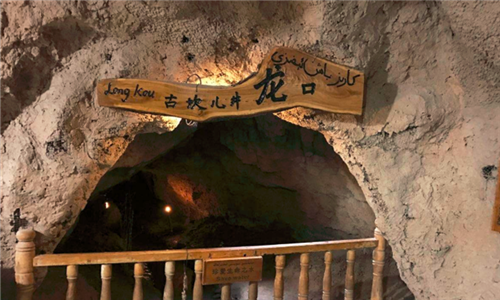
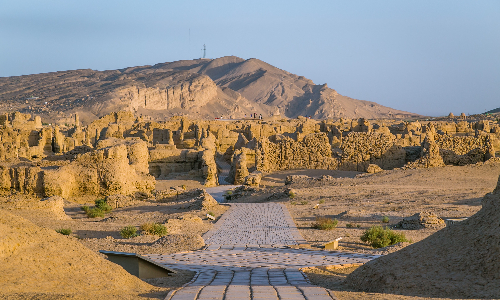
After breakfast, you will set off to Bezeklik Thousand Buddha Caves. Bezeklik means “mountainside” in the Uygur language and “decorative paintings” in Turkic. Located on a cliff of the Flaming Mountains, the caves are the complex of Buddhist grottoes, whose construction was started in the late Northern and Southern Dynasties (420-589) and finally completed in the Yuan Dynasty (1271-1368). The complex is composed of three stories with 57 extant grottoes and more than 40 murals, covering an area of 1,200 square meters. As the Buddhism center of ancient Gaochang Kingdom, the caves used to be the royal temple and now is one of the largest sites of the same kind in Xinjiang. The murals in the caves is the highlight of the tour, most of which were created in the Tang Dynasty. Some of the murals portray Buddhist stories including the promise of Sakyamuni Buddha in his previous lives, some depict the life of the ancient Manichaean, and some are the portraits of the king and the queen of the ancient Gaochang Kingdom. Moreover, some murals are with inscriptions written in Chinese, old Uyghur languages, Sanskrit, and Tocharian. When creating the murals, a large amount of mineral pigment was used, which has good oxidation resistance. Besides, thanks to the dry climate in Turpan, these murals are still of fresh color despite the passage of time.
After the tour in the grottoes, you will go to the Flaming Mountains. As the most famous attraction in Turpan Basin, the mountain consists of crimson sandstone, conglomerate, and mudstone. Therefore, it is also called the “Red Mountain” by local people. Without any plants, the red mountain looks shiny in the sun, and the slopes make the mountain look like a burning flame. That’s how the mountain gets its name, and the mountain deserves the name. As the hottest place in China, the highest temperature here can reach 47.8 degrees centigrade in summer and the surface temperature can even reach 89 degrees centigrade. It is so hot that even eggs can be roasted in the sand. What’s more, the mountains are associated with mysterious legends and tales. One of the folk tales among the Uyghur people has it that an evil dragon was killed in this place and its blood was shed on the mountain, thus making the whole mountains red. More interestingly, many people said the mountain looks like a crouching dragon from the distance.
After the tour in the morning, having a nice lunch and taking a short break will be a great choice.
In the afternoon, you will visit Gaochang Ruins. Covering an area of two million square meters, it is the largest city ruins in China. The city of Gaochang used to be a dominating place in the Turpan Basin from the Western Han Dynasty (202BC-8AD) to the Ming Dynasty (1368-1644), boasting more than 1,400 years. The city consists of the outer city, the inner city, and the imperial city where the Khan (the supreme ruler of the region) lived. The layout of the imperial city here is quite similar to that of Chang’an (now Xi’an). Therefore, an archaeologist once said that if you are wondering what the city of Chang’an in the Tang Dynasty looked like, just come to find out the answer in Gaochang Ruins.
At the same time, as an important city along the ancient Silk Road, Gaochang was a business hub connecting Central China, Central Asia, and Europe in ancient times. Although many of the buildings have been destroyed and even disappeared over the past two thousand years, visitors can still see many sites of religious buildings and palaces scattered inside the city, especially a temple located in the southwest of the outer city. The temple was named Dafo Temple, meaning “Giant Buddha Temple”, and the main hall and the depository of Buddhist Sutras can still be found. It is said that the historical Buddhist monk Xuanzang from the Tang Dynasty once gave Sutra lectures in this temple on his pilgrimage for Buddhist Scriptures to ancient India, and later this story became a part of the Journey to the West, one of the Four Great Classics of Chinese literature.
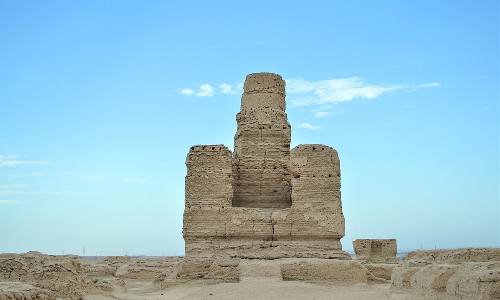
 Urumqi
Urumqi After Breakfast, you will head back to Urumqi, and then have lunch and take a short break.
In the afternoon, you will go to Heavenly Lake to enjoy the beauty of nature. Located on the mountainside of Bogda Peak, the lake is about 80 kilometers away from Urumqi, and we will drive northeast for about 70 minutes. As a famous sightseeing spot, the lake attracts millions of tourists from home and abroad. The lake is surrounded by forests and the snow peak in the distance can be in sight even in summer. You can have a good chance to breathe fresh air and relax. What’s more, visitors will be not only amazed by its breathtaking natural landscape but also fascinated by mysterious stories. The lake was associated with many legends about Queen Mother on the Heaven as it is said that she once held banquets and lived here. Beside the lake, there stands an ancient elm tree which is said to be the avatar of the hairpin of Queen Mother on Heaven.
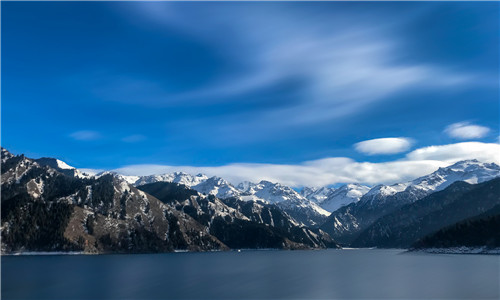
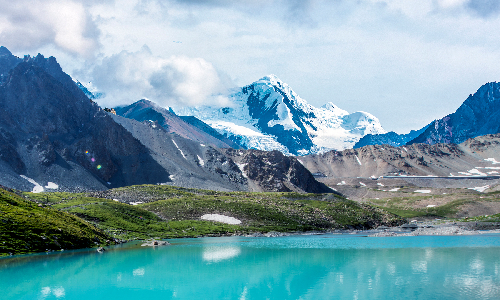
 Kashgar
Kashgar After breakfast, you will take the estimated flight UQ2581 11:55/14:00 to Kashgar. Our professional guide will be waiting for you at the arrival hall.
Kashgar, literally meaning “the place of jade”, is located in the southwest of Xinjiang. As a key place along the ancient Silk Road, it used to be an international commercial hub where Chinese and international merchants gathered. Moreover, it is also the only national historic and cultural city in Xinjiang, embodying the characteristics and essence of Uyghur folk customs, culture, art, and architectural styles. Your tour in Kashgar will be worthwhile.
After picking you up from the airport, your guide will take you to the Kashgar Big Bazaar. Situated at the East Gate of the city of Kashgar, the bazaar is the largest market for international trade and commerce in Northwestern China. Enjoying a history of over 2,000 years, the bazaar was known as “the largest market in Asia” in ancient times, and many merchants coming from Central China as well as other countries and regions gathered here to do business with each other at that time. Now there are more than 5,000 stands with almost ten thousand kinds of goods for sale. Strolling around the market, you will experience the most genuine folk customs of the Uyghur people in Xinjiang. Moreover, if you would like to buy some local specialties or gifts, the market will be a great place to go.
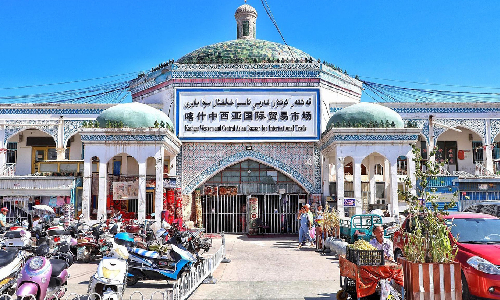
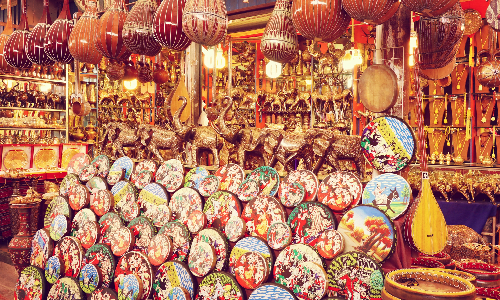
In the morning, you will have breakfast at the hotel and then set out to the first stop of today’s tour: Abakh Khoja Tomb. With a history of more than 300 years, the tomb is a typical ancient Islamic tomb complex and also the resting place of a descendent of Muhammad, the Islamic Prophet. It is just like a magnificent palace, which consists of an arch, mosques, and main tombs burying 72 people of the same family. The tomb is also better known as the Tomb of Xiang Fei (literally fragrant imperial concubine), in China, many people believe the only Uyghur concubine of Emperor Qianlong in the Qing Dynasty (1636-1912) was buried in the place. According to the legend, the concubine was born with a special fragrance, and when she was dancing, even butterflies would be attracted to fly around her.
Near the Abakh Khoja Tomb stands the Id Kah Mosque. Built in 1442, the mosque is an ancient building complex with strong ethnic styles and religious features. During the Ming Dynasty, a leader in Kashgar died and was buried in this place, and then his descendent built a small mosque here. From that time on, the mosque became an important institution to spread Islamic culture. Over the past 600 years, the mosque experienced three extensions and becomes what it looks like today. Now covering an area of 16.8 thousand square meters, it is the largest mosque in Xinjiang.
After the tour in the morning, you will have lunch and then take a short break. Then, you will head to Kashgar Old Town, its unique charm is waiting for you to experience. Enjoying a history of more than 2,100 years, the town is located in the center of the city of Kashgar. It is not only one of the largest earthen building complexes existing in the world but also the only extant historical block with typical features of the West Region in China. Despite the passage of time, people living in the old town still keep their traditional customs and habits, and the traditional buildings with exquisite brick carvings along the streets will make you feel as if you are wandering through a city in ancient times. Instead of ensuring a perfect axially symmetrical layout like other cities or towns in China, the old town developed flexibly and naturally with the Id Kah Mosque being in the center. With 13 main streets and nearly one hundred alleys, the town boasts various bazaars for traditional kerchiefs, carpets, clay wares, and ornaments. What’s more, foodies should not miss the chance to try some local specialties in the town. Lamb skewers, pomegranate juice, and crusty pancakes are highly recommended.
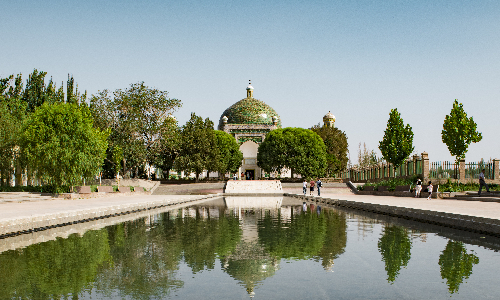
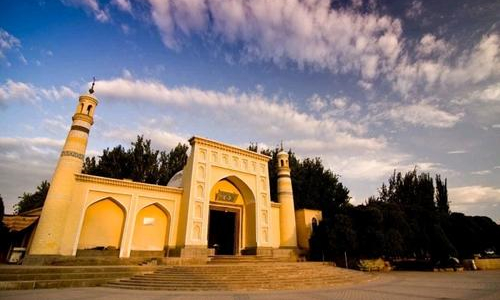
Your 7-day tour in Xinjiang, China is to come to an end. After breakfast, our guide will pick you up at the hotel and then take you to the airport. Hope you have had a good stay in China. Any advice about the tour from you is welcome. Have a safe flight!
Author: Chunlei Peng
Proofreader: Betsy He
| City | Five Star hotel list | Four Star hotel list |
|---|---|---|
| Urumqi | Grand Mercure Urumqi Hualing | Tumaris Hotel |
| Turban | Mercure Hotel Turpan Downtown | Jinjiang Metropolo Hotel - Turpan Administration Center |
| Kashgar | Yue Xing Jin Jiang International Hotel | Tarim Petroleum Hotel |
 |
![]() About your child or infant, please contact us for a discounted price.
About your child or infant, please contact us for a discounted price.



We started with a few days in Beijing & ended in Shanghai, from where we visited the Forbidden City and Great Wall. In between we visited Terra Cotta Warriors Museum, Panda Base, Shanghai Disneyland.

We had a wonderful holiday in China which will remain long in the memory. China is a breathtakingly beautiful country full of splendid temples and palaces, mountains and rivers, peaceful rural scenes and bustling shopping streets.
 QUICK ENQUIRY
QUICK ENQUIRY